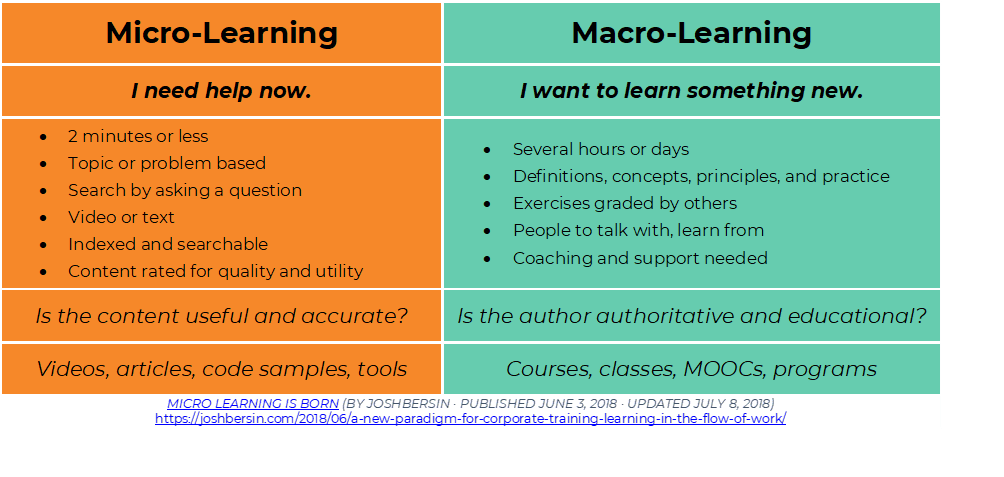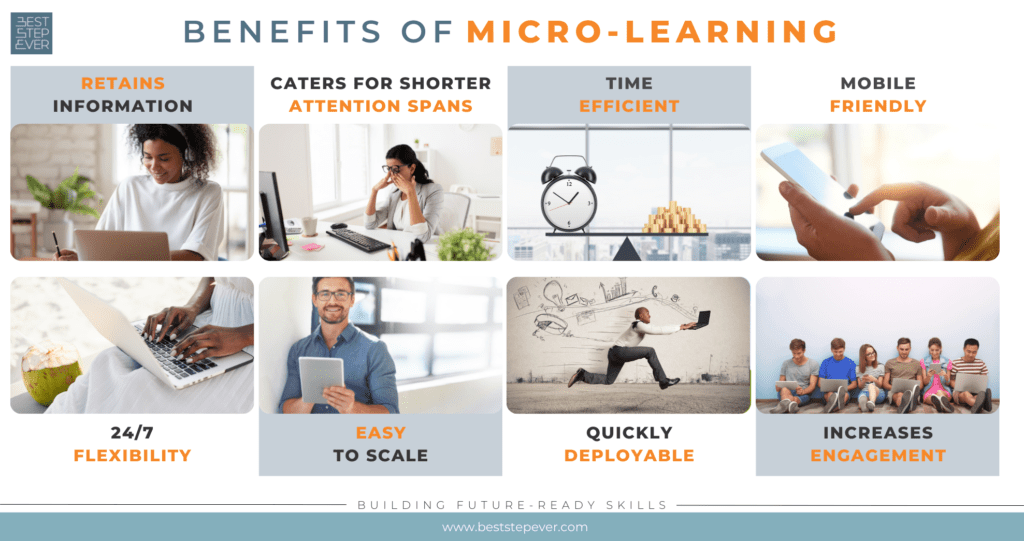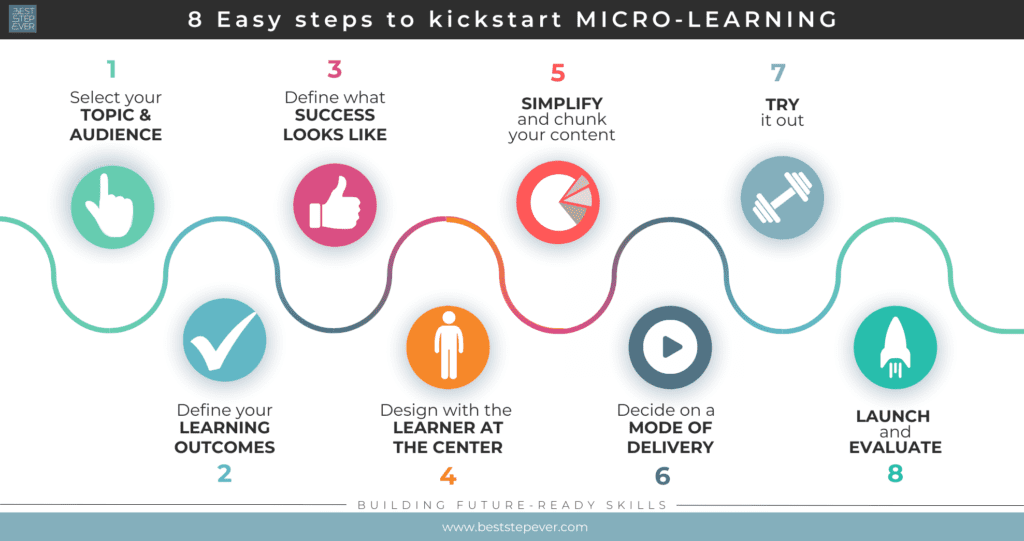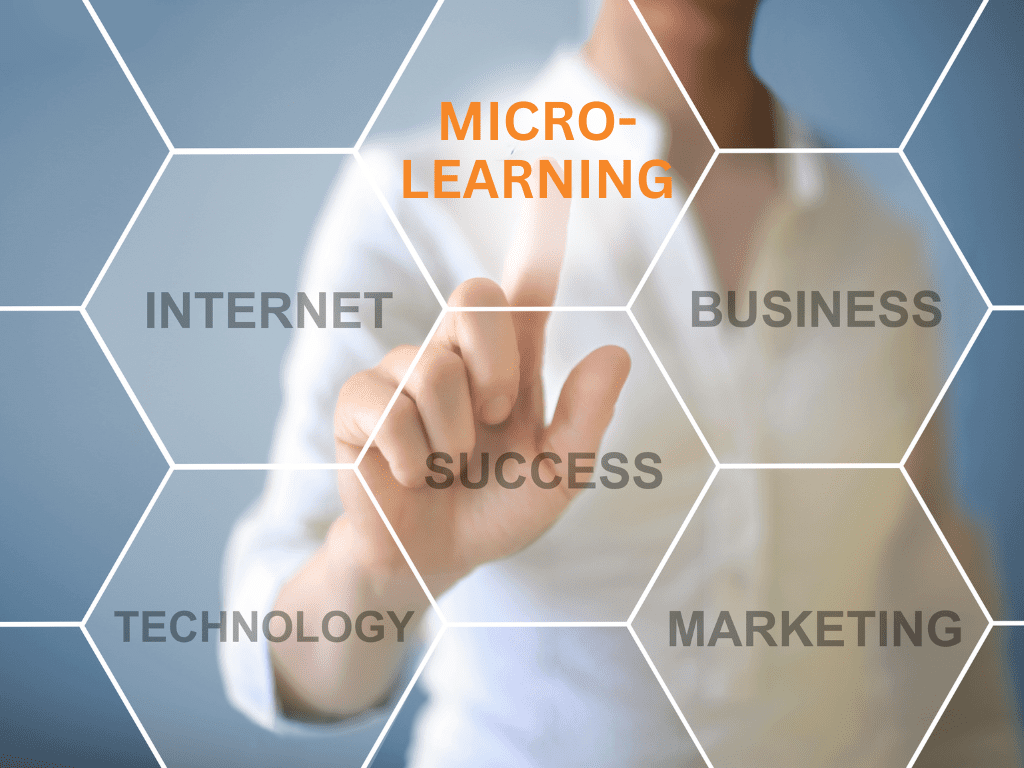WHAT IS MICRO-LEARNING REALLY?

At its best, micro-learning consists of short, sharp nuggets of information presented in a memorable and learner-centered way to achieve a specific goal. Like an earworm – a catchy tune that you can’t get out of your mind.
It’s been around for quite a while and it’s nothing new. Except that it’s gaining new prominence due to the speed of change in the workplace. And lack of time for more traditional earning methods.
How short is short? Well, the consensus amongst the learning community is that the nugget should definitely not be longer than 15 minutes and that 2 to 5 minutes is considered ideal.
Should the nugget be part of a bigger picture? Usually yes. It’s a way of presenting and conveying information to make it easier to digest (think canapes rather than a huge plate of food). At the end of the day the calorie count may be the same, but the process was lighter and more enjoyable.
Micro-learning happens all around us, all the time. It’s our favourite go-to for quick answers. Perhaps yesterday you needed help with an Excel formula, so you hopped onto YouTube for a quick explanation. That’s micro-learning. Perhaps you wanted a recipe for a specific dish, so you watched a quick online video – that’s also micro-learning. Once you know what you’re looking at, you’ll realise how much the convenience of micro-learning has permeated your daily life
The global COVID-19 pandemic changed trends in digital learning and greatly accelerated the pace of online learning. This in turn has impacted the frequency and popularity of micro-learning as a corporate go-to for quick results.
Is it effective though?
Research indicates that it’s highly effective in certain contexts.
A large part of this has to do with the forgetting curve. German psychologist Hermann Ebbinghaus showed us how the average learner forgets about 50% of what they learned in class within one day. After a month, they’ve forgotten about 90%.
He also found that learners are more likely to remember if there is repetition of what they learnt, to jog the mind to remember more.
When we get a lot of information in a short space of time, mental fatigue kicks in and we stop remembering. That’s where micro-learning is so effective – short sharp bursts of information that we are more likely to retain – particularly if the information was colourful, vivid, or otherwise visually memorable.
Patti Shank has provided a great summary of what research has to say about the effectiveness or otherwise of micro-learning. Her conclusion: research confirms that it makes learning seem easier, helps people learn something small, quickly, and helps people fit bits of small learning into their hectic work and life.
What are the differences between micro-learning and macro-learning?
Josh Bersin provides the clearest example in his table, replicated here below, in his 2018 article on a new paradigm for corporate learning: 
Basically, micro-learning focuses on learning something relevant, right now. Macro-learning focuses more on the bigger picture and on progressive learning over a longer period of time.
Both have their place. They should be seen as complementary to each other and not exclusive.
Benefits of micro-learning
Micro-learning isn't the answer to everything. However, used in the right way at the right time it has powerful benefits.
Let’s examine some of the benefits of micro-learning.

a) Retaining information
Retention is one of the huge benefits of micro-learning. The learning sticks – because it’s small and manageable. It’s usually one concept or application that’s covered at a time. This also means that we are likely to have better recall in the weeks and months after the learning segment took place. And that’s a powerful return on investment!
When done smartly, micro-learning provides an element of repetition which helps the process of retaining information.
b) Caters to shorter attention spans
Admit it. Most of us aren’t blessed with the ability to concentrate and retain information for a lengthy period of time – even if we find the content riveting. Because we know that a micro-learning nugget is short, we’re much more likely to minimize disruptions and concentrate on the topic at hand. We know that it will be over soon so we’re more comfortable with giving dedicated focus as the end is in mind.
c) Time-efficient
Who has time to spare? Not many of us. And that’s the beauty of micro-learning. Often we can’t find hours or days for learning. However, a short slot of under 15 minutes feels much more achievable. And if the learning gives us immediate value, that’s a win all round.
d) Mobile-friendly
Most micro-learning is designed to be accessible and online which is reachable via multiple platforms – laptop, tablet, phone etc. So you can cover a learning nugget whilst you’re on public transport, or waiting for a meeting to start, or having your coffee. Mostly you don’t have to be in a specific place or use specific hardware. You have access to learning right in your pocket on your smartphone.
e) 24/7 Flexibility
The predominantly online and asynchronous nature of micro-learning means that (mostly) you can do it anytime, anywhere, at your convenience. This is of huge help to early birds and late-night owls who have very different patterns of productivity.
f) Easy to scale
Micro-learning can reach many more people, much more quickly. The training reach can be greatly expanded without much extra effort. The same goes for updating and upgrading content. It’s so much quicker to do when the learning is segmented into smaller bits.
g) Quickly deployable
Designing an effective training intervention requires much time and effort. However, if the aim of the training has a narrow focus, for example to provide a quick update, or to present a short burst of new information, or a quick how-to guide, then micro-learning is a great solution. It’s quick to design and roll out.
h) Increased engagement
Research indicates that adult learners are far more likely to engage with the subject matter when a micro-learning approach is used. Mostly this is because it seems far more manageable and less time-greedy. Learners are far more likely to sign up for programs that are short and snappy. They know their likelihood of success is far greater than if they sign up for something much more comprehensive and demanding.
These eight benefits outlined above provide a powerful argument to look at ways to implement micro-learning in your workplace, if you aren’t doing so already. Most companies start their experimentation with micro-learning as part of their onboarding, compliance, or continuous professional development programs. These are great ways to start the journey and explore the benefits in a specific organizational context.
8 Easy steps to kickstart your micro-learning strategy

Let’s unpack an eight-step process to implement micro-learning in your organization:
1. Select the topic and the audience
First time round it’s always best to pick the low-hanging fruit. Perhaps an aspect of your onboarding needs an upgrade. Or you need to impart some must-have information to a segment of your company. Or you want to introduce a key skill to support an organizational culture initiative.
Whatever it is, clearly define your topic. Where does it start and where does it end?
And then define your audience. Who are they? What is their attitude likely to be towards the topic? What’s in it for them to participate in this learning?
2. What’s the desired learning outcome?
Next, clearly define the outcome you want to get out of the learning activity. Because if you don’t know where you’re going, how will you know when you get there? Think of the topic as a whole, and not the micro-chunks at this stage- that comes later.
Learning outcomes are about describing the end result that you want to achieve. And you need to describe it in a way that you can measure it. Which is much easier said than done. Learning outcomes are tricky things to get right. If you need a reminder, see a definition of learning outcomes here.
For the purposes of an example, I’m going to use a very basic topic that hopefully most of us can relate to – such as making a cup of tea.
Our learning outcome in this case would be “To enable the learner to prepare and serve a cup of tea to a visitor”
3. What does success look like?
Your learning outcome, if well defined, will clearly describe what the learner will be able to know, do or apply. Will this give you a successful outcome? How will you measure this success?
If you think about how you plan to measure success right up front, it’s easier to track your return on investment in micro-learning. And it will be easier for you to clearly demonstrate the benefits or otherwise of following this approach.
Our measure of success, in this case, could be that “Visitors drink the coffee that is being served to them and provide a rating of at least 7 out of 10 on a satisfaction scale”.
4. Simplify and chunk your content
Now that you’re defined your overall learning outcome, it’s time to simplify and chunk your content.
What are the logical mini learning outcomes that form part of the bigger picture? If you have more than 10 mini learnings, it’s usually a signal that you’re trying to group too much together. It may be time to revise your overall learning outcome and see if your topic needs to be reduced.
Mind maps or other visual aids are a very useful way to chunk your content into logical short sessions.
In this particular example we’re going to use the following segments:
a) Prepare to make the coffee (learning outcome being “the learner is able to prepare a defined area with all the required ingredients and tools to make coffee”)
b) Make the coffee (“the learner is able to use the appropriate tools to make coffee to a defined standard”
c) Serve the coffee (“the learner is able to provide a visitor with a comprehensive coffee tray with the coffee being at the correct temperature”
d) Tidy up and finish off (“the learner is able to clean all equipment and restore the coffee area to its previous state”)
5. Design with the learner at the centre
Being truly learner-centric is easier said than done! We need to design the learning process to be as easy and understandable as possible when done through the eyes of the learner.
At a minimum, this means that everything the learner needs in order to understand the topic needs to be easily accessible and close at hand. Support, feedback, and correction need to be easily available and done in a way that boosts the confidence of the learner.
As far as possible the learner should have an opportunity to practice the skills in a safe and supportive environment.
Accommodating different learning styles and using different learning methods ensures that learners are catered for in a way that matches their preferences.
6. Decide on your mode of delivery
What mode of delivery to use is greatly impacted by factors such as budget, geographic dispersion of learners, time availability, internal knowledge and expertise etc.
However, as social media has demonstrated, an awful lot can be done with a smart phone and free tools. Budgets may be limited but often this serves to boost creative thinking. Aiming for a “good enough” result now is far better than waiting another year for more resources that may never arrive.
Most typical modes of delivery for micro-learning include live learnings, explainer videos, micro presentations, infographics and mini podcasts. Other forms include whiteboard animations, interactive videos and gamification.
In our coffee-making example, here are some modes of delivery we could consider. For this practical task it’s important that we keep it visual.
- - Physical training session in a specific location.
- - Live online training
- - Instructional videos
- - Infographics
7. Try it out
Next, it’s time to try the concept out as a trial version on some willing learners. You’ll quickly find out through the eyes of the learner what works and what doesn’t. What’s too long and what’s too short. What’s boring and what’s interesting. What helps and what hinders.
You’ll get invaluable information from your guinea-pig learners about what to change and why. Focus first on what’s getting in the way of the learning experience. If there’s sufficient time, you can also work on the “nice to have” suggestions – but beware of getting bogged down in this. The purpose of your trail to is to uncover and fix problems, not to create perfection.
8. Launch and evaluate
And finally, it’s time to launch! The more you can create ease of access and widespread awareness, the better.
And that brings us to the final action – to evaluate your success. In Step 3 we asked you to identify what success looks like for you. Now’s the right time to measure whether your micro-learning activities are getting you the results that you want.
If your results are disappointing, it’s time to do a deep dive to discover exactly what’s getting in the way and what you need to change.
And if your results are looking good, it’s time to celebrate!
IN CONCLUSION
Micro-learning is more relevant today than ever in our time-deprived world. More and more it’s becoming a fundamental component of an organization’s online learning offering.
Has your organization embraced micro-learning?


